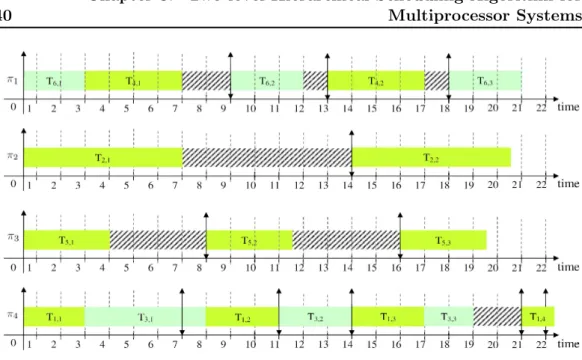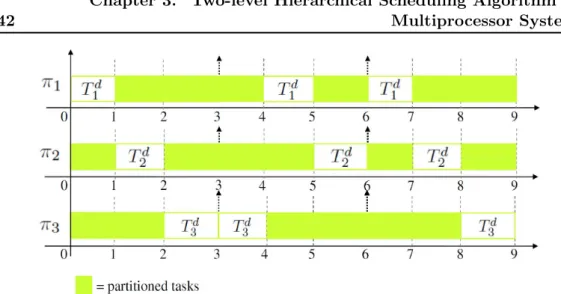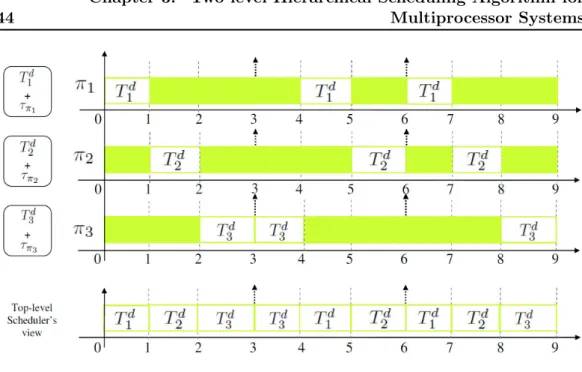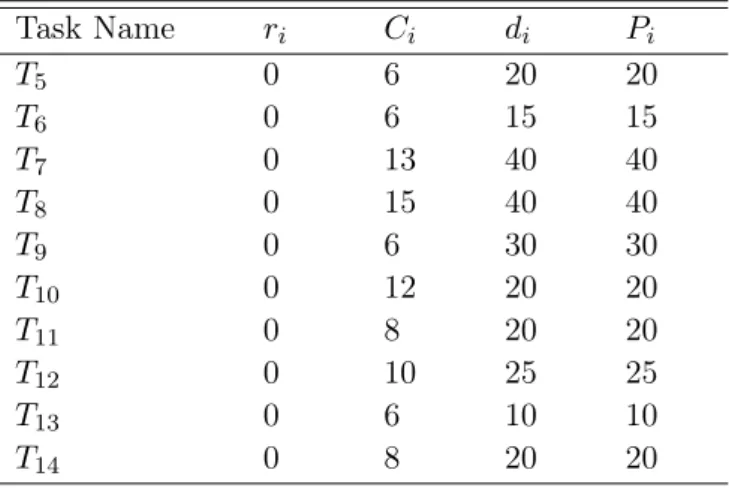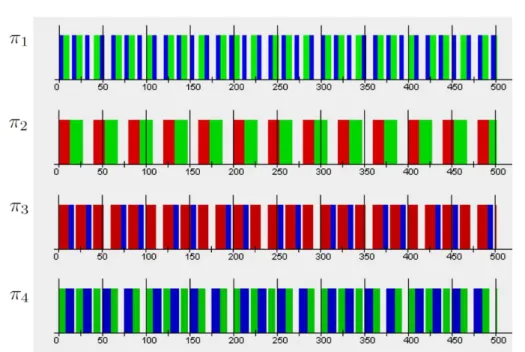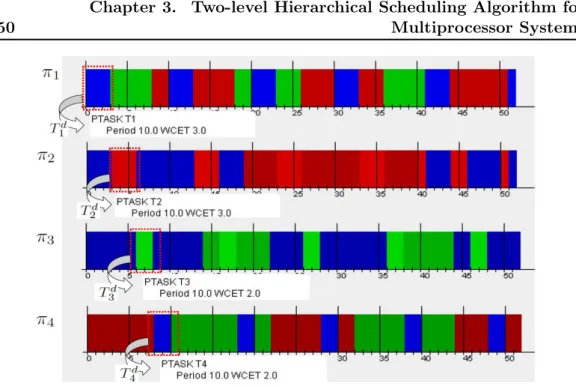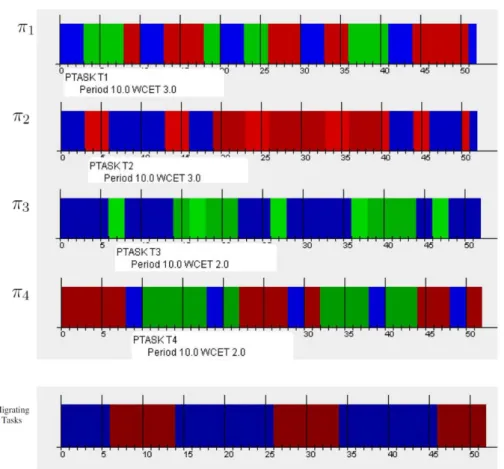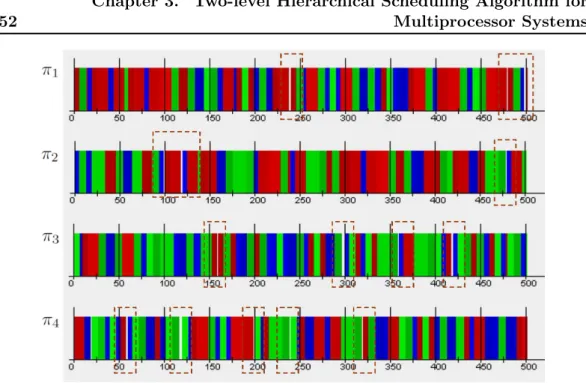HAL Id: tel-00599980
https://tel.archives-ouvertes.fr/tel-00599980
Submitted on 12 Jun 2011
HAL is a multi-disciplinary open access
archive for the deposit and dissemination of
sci-entific research documents, whether they are
pub-lished or not. The documents may come from
teaching and research institutions in France or
abroad, or from public or private research centers.
L’archive ouverte pluridisciplinaire HAL, est
destinée au dépôt et à la diffusion de documents
scientifiques de niveau recherche, publiés ou non,
émanant des établissements d’enseignement et de
recherche français ou étrangers, des laboratoires
publics ou privés.
temps-réel multiprocesseurs.
K. Bhatti
To cite this version:
K. Bhatti. Efficacité énergétique et ordonnancement des systèmes temps-réel multiprocesseurs. .
Embedded Systems. Université Nice Sophia Antipolis, 2011. English. �tel-00599980�
UNIVERSITÉ DE NICE - SOPHIA ANTIPOLIS
École Doctorale STIC
Sciences et Technologies de l’Information et de la Communication
THÈSE
pour obtenir le titre de
Docteur en Sciences
de l’Université de Nice - Sophia Antipolis
Mention Informatique
présentée et soutenue par
Muhammad Khurram BHATTI
Energy-aware Scheduling for
Multiprocessor Real-time Systems
Thèse dirigée par Cécile BELLEUDY
Laboratoire LEAT, Université de Nice-Sophia Antipolis -CNRS, Sophia Antipolis
soutenue le 18 avril 2011, devant le jury composé de:
Président du Jury
Lionel Torres Pr. Université de Montpellier-II, FranceRapporteurs
Isabelle Puaut Pr. Université de Rennes-I, France Guy Gogniat Pr. Université de Bretagne Sud, FranceExaminateurs
Yvon Trinquet Pr. Université de Nantes, France Lionel Torres Pr. Université de Montpellier-II, France Michel Auguin DR. CNRS, France (Co-directeur de thèse)Directeur de thèse
Cécile Belleudy Maître de Conférences,c
2011
Muhammad Khurram Bhatti
ALL RIGHTS RESERVED
iii
Abstract
Real-time applications have become more sophisticated and complex in their
behavior and interaction over the time. Contemporaneously, multiprocessor
archi-tectures have emerged to handle these sophisticated applications. Inevitably, these
complex real-time systems, encompassing a range from small-scale embedded devices
to large-scale data centers, are increasingly challenged to reduce energy
consump-tion while maintaining assurance that timing constraints will be met. To address
this issue in real-time systems, many software-based approaches such as dynamic
voltage and frequency scaling and dynamic power management have emerged. Yet
their flexibility is often matched by the complexity of the solution, with the
ac-companying risk that deadlines will occasionally be missed. As the computational
demands of real-time embedded systems continue to grow, effective yet
transpar-ent energy-managemtranspar-ent approaches will become increasingly important to minimize
energy consumption, extend battery life, and reduce thermal losses. We believe
that power- and energy-efficiency and scheduling of real-time systems are closely
re-lated problems, which should be tackled together for best results. By exploiting the
characteristic parameters of real-time application tasks, the energy-consciousness of
scheduling algorithms and the quality of service of real-time applications can be
significantly improved.
To support our thesis, this dissertation proposes novel approaches for
energy-management within the paradigm of energy-aware scheduling for soft and hard
real-time applications, which are scheduled over identical multiprocessor platforms. Our
first contribution is a Two-level Hierarchical Scheduling Algorithm (2L-HiSA) for
multiprocessor systems, which falls in the category of restricted-migration
schedul-ing. 2L-HiSA addresses the sub-optimality of EDF scheduling algorithm in
mul-tiprocessors by dividing the problem into a two-level hierarchy of schedulers. Our
second contribution is a dynamic power management technique, called the Assertive
Dynamic Power Management (AsDPM) technique. AsDPM serves as an admission
control technique for real-time tasks, which decides when exactly a ready task shall
execute, thereby reducing the number of active processors, which eventually reduces
energy consumption. Our third contribution is a dynamic voltage and frequency
scaling technique, called the Deterministic Stretch-to-Fit (DSF) technique, which
falls in the category of inter-task DVFS techniques and works in conjunction with
global scheduling algorithms. DSF comprises an online Dynamic Slack
Reclama-tion algorithm (DSR), an Online Speculative speed adjustment Mechanism (OSM),
and an m-Task Extension (m-TE) technique. Our fourth and final contribution is
a generic power/energy management scheme for multiprocessor systems, called the
Hybrid Power Management (HyPowMan) scheme. HyPowMan serves as a top-level
entity that, instead of designing new power/energy management policies (whether
DPM or DVFS) for specific operating conditions, takes a set of well-known
exist-ing policies. Each policy in the selected policy set performs well for a given set of
operating conditions. At runtime, the best-performing policy for given workload is
adapted by the HyPowMan scheme through a machine-learning algorithm.
v
To my father Ismail, who always dared to dream,
and to my mother Mumtaz (late) for making it a reality.
vii
Acknowledgments
Completion of my PhD required countless selfless acts of support, generosity,
and time by people in my personal and academic life. I can only attempt to humbly
acknowledge and thank the people and institutions that have given so freely
through-out my PhD career and made this dissertation possible. I am thankful to the Higher
Education Commission (HEC) of Pakistan for providing uninterrupted funding
sup-port throughout my Masters and PhD career. I am sincerely thankful to Cécile
Belleudy, my advisor, for being a constant source of invaluable encouragement, aid,
and expertise during my years at University of Nice. While many students are
for-tunate to find a single mentor, I have been blessed with two. I am deeply grateful
to Michel Auguin, my co-advisor, for the guidance, support, respect, and kindness
that he has shown me over the last four years. The mentoring, friendship, and
colle-giality of both Cécile and Michel enriched my academic life and have left a profound
impression on how academic research and collaboration should ideally be conducted.
I am extremely thankful to the members of my dissertation committee. Guy
Gogniat and Isabelle Puaut have graciously accepted to serve on the committee
as reviewers and provided unique feedback, comments, and questions on
multipro-cessor scheduling, along with a lot of encouragement. Yvon Trinquet has provided
me with wise advice and support throughout my PhD and also accepted to be a
part of my dissertation committee. I have always admired his precise questions and
unique manner of addressing difficult research problems. Lionel Torres has been
very kind for accepting to be the president of dissertation committee and a source
of insightful comments and ideas to my research and its effective presentation. I
must acknowledge that all these people have greatly inspired me. Other colleagues
who I owe gratitude for their support of my research or major PhD milestones
in-clude: Sébastian Bilavarn, Francois Verdier, Ons Mbarek, and Jabran Khan. I am
also grateful to the always helpful LEAT research laboratory and University of Nice
staff. I would like to thank all my research collaborators who have enhanced my
en-thusiasm and understanding of real-time systems through various projects, namely;
the collaborators of Pherma, COMCAS, and STORM tool design and development
projects. Since the path through the PhD program would be much more difficult
without examples of success, I am indebted to Muhammad Farooq who has given
friendship and guidance as recent real-time system PhD graduate from LEAT.
My family and friends have been an unending source of love and inspiration
throughout my PhD career. My father, Ismail, has offered unconditional
under-standing and encouragement. My sisters, Shaista and Sofia, have kept me sane with
their humor and understanding even from distance. My brother, Asad, has been a
great and selfless support to me throughout these year of my absence from home.
My friends in French Riviera, Najam, Naveed, Uzair, Sabir, Chafic, Umer, Siouar,
Khawla, Amel, Alice, and Sébastian have provided hours of enjoyable distraction
from my work. I will always remember the time I have shared with them. Lastly,
I can only wish if my mother, Mumtaz, was still alive to embrace me on achieving
this milestone. She will always remain my constant.
Contents
I
Complete dissertation:
English version
1
1
Introduction
3
1.1
Introduction
. . . .
3
1.2
Contributions
. . . .
5
1.3
Summary
. . . .
8
2
Background on Real-time and Energy-efficient Systems
11
2.1
Real-time Systems
. . . .
11
2.1.1
Real-time Workload
. . . .
12
2.1.2
Processing Platform
. . . .
16
2.1.3
Real-time Scheduling
. . . .
17
2.1.4
Real-time Scheduling in Multiprocessor Systems
. . . .
20
2.2
Power- and Energy-efficiency in Real-time Systems
. . . .
23
2.2.1
Power and Energy Model
. . . .
23
2.2.2
Energy-aware Real-time Scheduling
. . . .
26
2.3
Simulation Environment
. . . .
28
2.4
Summary
. . . .
29
3
Two-level Hierarchical Scheduling Algorithm for Multiprocessor
Systems
31
3.1
Introduction
. . . .
31
3.2
Related Work
. . . .
32
3.3
Two-level Hierarchical Scheduling Algorithm
. . . .
35
3.3.1
Basic Concept
. . . .
36
3.3.2
Working Principle
. . . .
37
3.3.3
Runtime View of Schedule from Different Levels of Hierarchy
41
3.3.4
Schedulability Analysis
. . . .
44
3.4
Experiments
. . . .
47
3.4.1
Setup
. . . .
47
3.4.2
Functional Evaluation
. . . .
47
3.4.3
Energy-efficiency of 2L-HiSA
. . . .
50
3.4.4
Performance Evaluation
. . . .
52
3.5
Concluding Remarks
. . . .
55
4
Assertive Dynamic Power Management Technique
57
4.1
Dynamic Power Management
. . . .
57
4.2
Related Work
. . . .
58
4.3
Assertive Dynamic Power Management Technique
. . . .
61
4.3.1
Laxity Bottom Test (LBT)
. . . .
62
4.3.3
Choice of Power-efficient State
. . . .
68
4.4
Static Optimizations using AsDPM
. . . .
69
4.5
Experiments
. . . .
69
4.5.1
Target Application
. . . .
69
4.5.2
Simulation Results
. . . .
73
4.5.3
Comparative Analysis of the AsDPM Technique
. . . .
78
4.6
Future Perspectives of the AsDPM Technique
. . . .
79
4.6.1
Memory Subsystem
. . . .
80
4.6.2
Thermal Load Balancing
. . . .
82
4.7
Concluding Remarks
. . . .
84
5
Deterministic Stretch-to-Fit DVFS Technique
85
5.1
Dynamic Voltage and Frequency Scaling
. . . .
85
5.2
Related Work
. . . .
87
5.3
Deterministic Stretch-to-Fit Technique
. . . .
90
5.3.1
Dynamic Slack Reclamation (DSR) Algorithm
. . . .
90
5.3.2
Online Canonical Schedule
. . . .
93
5.3.3
Online Speculative speed adjustment Mechanism (OSM)
. . .
97
5.3.4
m-Tasks Extension Technique (m-TE)
. . . .
98
5.4
Experiments
. . . .
98
5.4.1
Setup
. . . .
99
5.4.2
Target Application
. . . .
99
5.4.3
Simulation Results
. . . .
99
5.5
Concluding Remarks
. . . 104
6
Hybrid Power Management Scheme for Multiprocessor Systems
107
6.1
Introduction
. . . 107
6.2
Related Work
. . . 108
6.3
Hybrid Power Management Scheme
. . . 109
6.3.1
Machine-learning Algorithm
. . . 110
6.3.2
Selection of Experts
. . . 114
6.4
Experiments
. . . 114
6.4.1
Setup
. . . 114
6.4.2
Description of Experts
. . . 115
6.4.3
Simulation Results
. . . 116
6.5
Concluding Remarks
. . . 120
7
Conclusions and Future Research Perspectives
123
7.1
Summary of Contributions and Results
. . . 124
7.2
Future Research Perspectives
. . . 127
7.2.1
Task Models
. . . 127
7.2.2
Platform Architectures
. . . 128
7.2.3
Scheduling Algorithms
. . . 128
Contents
xi
7.2.5
Thermal Aspects
. . . 130
7.3
Summary
. . . 130
II
Selected chapters:
French version
133
1
Introduction
135
1.1
Introduction
. . . 135
1.2
Contributions
. . . 137
1.3
Résumé
. . . 140
2
Conclusions et Perspectives
143
2.1
Résumé des Contributions et Résultats
. . . 144
2.2
Perspectives
. . . 147
2.2.1
Modèle des tâches
. . . 147
2.2.2
Architectures de Plate-forme Cible
. . . 148
2.2.3
Les algorithmes d’ordonnancement
. . . 149
2.2.4
Stratégie d’implementation
. . . 150
2.2.5
Aspects Thermiques
. . . 150
2.3
Résumé
. . . 151
A STORM: Simulation TOol for Real-time Multiprocessor
Schedul-ing
155
A.1 Functional Architecture
. . . 156
A.1.1
Software Entities
. . . 157
A.1.2
Hardware Entities
. . . 158
A.1.3
System Entities
. . . 159
A.1.4
Simulation Kernel
. . . 159
B HyPowMan Scheme: Additional Simulation Results
161
B.1 Simulation Results Using AsDPM & DSF Experts
. . . 161
B.1.1
Effect of variations in bcet/wcet ratio
. . . 161
B.1.2
Effect of variations in number of tasks
. . . 161
B.1.3
Effect of Variations in total utilization
. . . 162
B.2 Simulation Results Using ccEDF & DSF Experts
. . . 163
List of Algorithms
1
Offline task partitioning to processors
. . . .
38
2
Offline processor-grouping
. . . .
39
3
Local-level scheduler: Online jobs assignment for partitioned tasks
present in τ
πk. . . .
43
4
Top-level scheduler:
Online jobs assignment for migrating tasks
present in τ
glob. . . .
43
5
Assertive Dynamic Power Management
. . . .
65
6
Dynamic Slack Reclamation
. . . .
91
7
Online Speculation Mechanism
. . . .
98
8
m-Tasks Extension Technique
. . . .
98
List of Figures
2.1
Illustration of various characteristic parameters of real-time tasks.
Periodic task T
ihas an implicit deadline (d
i=P
i) with the following
values of other parameters. O
i=2, C
i=3, d
i=P
i=4, and L
i=1.
. . . .
15
2.2
High-level illustration of symmetric share-memory multiprocessor
(SMP) architecture layout of processing platform.
. . . .
18
2.3
No migration scheduling.
. . . .
21
2.4
Full migration scheduling.
. . . .
21
2.5
Restricted migration scheduling.
. . . .
21
2.6
Current and future trends in the evolution of portable embedded
system demand, their power consumption, and their energy-density
in batteries. (a) Evolution of the demand for portable equipment
over the years (SEMICO Research Corp.). (b) Power consumption
in portable equipment over the years (ITRS 2008). (c) Evolution of
energy-density in batteries over the years (EPoSS 2009).
. . . .
24
2.7
Example of energy management decision-making of DPM technique.
27
2.8
Example of energy management decision-making of DVFS technique.
27
3.1
Job-splitting of a migrating task over three processors.
. . . .
33
3.2
Two-level hierarchical scheduling approach based on restricted
migra-tion.
. . . .
36
3.3
Example schedule of partitioned tasks under EDF scheduling
al-gorithm on SMP architecture (n=6, m=4), illustrating the
under-utilization of platform.
. . . .
40
3.4
Illustration of T
kdoccurring on different processors with respect to
the proportionate under-utilization available on each processor.
. . .
42
3.5
View of runtime schedule by top-level and local-level schedulers under
2L-HiSA on an SMP architecture.
. . . .
44
3.6
Simulation traces of partitioned tasks under EDF local scheduler on
each processor.
. . . .
49
3.7
Simulation traces of partitioned tasks in the presence of T
kdunder
EDF local scheduler on each processor.
. . . .
50
3.8
Simulation traces of migrating and partitioned tasks together under
EDF local- and top-level schedulers.
. . . .
51
3.9
Simulation traces of EDF global scheduling of task set τ on four
processors.
. . . .
52
3.10 Simulation traces of individual tasks under global EDF scheduler
. .
53
3.11 Number of task preemptions under 2L-HiSA, PFair (P D
2), and
ASEDZL algorithms.
. . . .
54
3.12 Number of task migrations under 2L-HiSA, PFair (P D
2), and
ASEDZL algorithms.
. . . .
55
4.1
Laxity Bottom Test (LBT) using anticipative laxity l
i.
. . . .
64
4.2
Schedule of τ using global EDF scheduler. (a) Without AsDPM. (b)
With AsDPM.
. . . .
65
4.3
Impact of an intermediate priority task’s release. (a) Projected
sched-ule of tasks at time t
cwithout intermediate priority task T
3. (b)
Pro-jected schedule of tasks at time t
c+1with intermediate priority task
T
3.
. . . .
68
4.4
Block diagram of H.264 video decoding scheme.
. . . .
70
4.5
Block diagram of H.264 decoding scheme slices version.
. . . .
71
4.6
Block diagram of H.264 decoding scheme pipeline version.
. . . .
72
4.7
Simulation results on the changes in energy consumption for H.264
video decoder application (slices version) for various frequencies.
. .
73
4.8
Simulation results on energy consumption under statically
non-optimized EDF schedule and statically non-optimized EDF schedule using
AsDPM for H.264 video decoder application (slices version).
. . . . .
77
4.9
Simulation results on energy consumption under statically
non-optimized EDF schedule and statically non-optimized EDF schedule using
AsDPM for H.264 video decoder application (pipeline version).
. . .
78
4.10 Simulation results on the energy consumption under statically
non-optimized EDF schedule, statically non-optimized EDF schedule using
AsDPM, and EDF schedule using online AsDPM for H.264 video
decoder application (slices version).
. . . .
79
4.11 Simulation results on the energy consumption under statically
non-optimized EDF schedule, statically non-optimized EDF schedule using
AsDPM, and EDF schedule using online AsDPM for H.264 video
decoder application (pipeline version).
. . . .
80
4.12 Simulation results on energy consumption of AsDPM in comparison
with ideal DPM technique under the control of EDF scheduling
algo-rithm for H.264 video decoder application (slices version).
. . . .
81
4.13 Energy consumption in memory subsystem using multi-bank
archi-tecture. (a) Energy consumption of multi-bank memory under global
EDF schedule without AsDPM. (b) Energy consumption
optimiza-tion of multi-bank memory under global EDF schedule using AsDPM.
83
5.1
Dynamic slack redistribution of a task under various DVFS strategies.
88
5.2
Slack reclamation using the DSR algorithm.
. . . .
93
5.3
Simulation traces of example task set on a single processor. a)
Canon-ical schedule of tasks where all tasks execute with worst-case
execu-tion time. b) Practical schedule of tasks where T
1finishes earlier than
its WCET and T
1exploits dynamic slack to elongate its WCET at
runtime.
. . . .
94
5.4
Task T
2consumes ε to elongate its execution up to its termination
instant in canonical schedule.
. . . .
95
List of Figures
xvii
5.6
Construction of online canonical schedule ahead of practical schedule
for m-tasks.
. . . .
96
5.7
Simulation results of H.264 slices version.
. . . 100
5.8
Simulation results of H.264 pipeline version.
. . . 101
5.9
Simulation results of H.264 pipeline version illustrating the
effective-ness of OSM.
. . . 102
5.10 Comparative analysis of simulation results of H.264 slices version.
. . 103
5.11 Comparative analysis of simulation results of H.264 pipeline version.
104
6.1
Interplay of DPM and DVFS policies.
. . . 109
6.2
Arrangement of expert set under the HyPowMan scheme for an SMP
architecture.
. . . 110
6.3
Example of the weight and probability update of a DPM-based expert.
112
6.4
Simulation results on variation of bcet/wcet ratio.
. . . 117
6.5
Simulation results on variation in number of tasks.
. . . 118
6.6
Simulation results on variation in aggregate utilization.
. . . 119
6.7
Simulation results on variation in α.
. . . 120
6.8
Simulation results on variation in β.
. . . 121
A.1 STORM simulator input and output file system.
. . . 156
A.2 Functional architecture of STORM simulator.
. . . 157
A.3 STORM: various states for application tasks.
. . . 157
A.4 STORM: example XML file.
. . . 158
B.1 Simulation results on variation of bcet/wcet ratio.
. . . 162
B.2 Simulation results on variation in number of tasks.
. . . 162
B.3 Simulation results on variation in aggregate utilization.
. . . 163
B.4 Simulation results on variation in bcet/wcet ratio.
. . . 164
B.5 Simulation results on the usage of experts under the HyPowMan scheme.
164
List of Tables
2.1
Voltage-frequency levels of PXA270 processor
. . . .
29
2.2
Power-efficient states of PXA270 processor @ 624-MHz & 1.55-volts
.
29
3.1
Real-time periodic task set τ
. . . .
48
3.2
Parameters of dummy tasks (T
kd) on each processor
. . . .
48
4.1
H.264 video decoder application task set for slices version
. . . .
71
4.2
H.264 video decoder application task set for pipeline version
. . . . .
72
4.3
Static architecture configurations for H.264 video decoder slices version
74
4.4
Static architecture configurations for H.264 video decoder pipeline
version
. . . .
75
4.5
Static optimal architecture configurations for H.264 video decoder
slices version for different QoS requirements
. . . .
76
4.6
Static optimal architecture configurations for H.264 video decoder
pipeline version for different QoS requirements
. . . .
76
5.1
Simulation settings for H.264 video decoder slices version
. . . 100
5.2
Simulation settings for H.264 video decoder pipeline version
. . . 101
6.1
Simulation settings for variable bcet/wcet ratio
. . . 116
6.2
Simulation settings for variable number of tasks
. . . 117
6.3
Simulation settings for variable aggregate utilization
. . . 118
6.4
Simulation settings for variable α
. . . 119
6.5
Simulation settings for variable β
. . . 120
B.1 Simulation settings for variable bcet/wcet ratio
. . . 163
Symbols and Acronyms
Symbols
Definition
t
Time instant
τ
Task set
T
iIndividual task indexed as i
T
i,jIndividual job j of task T
iJ
Job set
r
iRelease time of task T
iC
iWorst-case execution time (WCET) of task T
id
iRelative deadline of task T
iP
iPeriod of task T
iO
iOffset of first job T
i,1of T
iw.r.t. system activation
L
iAbsolute laxity of task T
il
iAnticipative laxity of task T
iu
iUtilization of individual task T
iU
sum(τ )
Utilization of task set τ
π
kIndividual processor indexed as k
Π
Processor set/ platform
n
Number of tasks in τ
m
Number of processors in Π
ν
Speed of processor π
kF
opOperating frequency
V
opOperating voltage
V
thThreshold voltage
E
Energy
ε
Dynamic slack
φ
Scaling factor
P wr(ν)
Power as function of speed ν
τ
πkSubset of tasks partitioned on processor π
kS
canCanonical Schedule of tasks
S
praPractical Schedule of tasks
DBF (τ, L)
Demand Bound Function of task set τ over interval
of length L
N
Number of Experts (where, expert is any power
management scheme)
w
Weight factor for individual expert
W
Weight vector for expert set
List of Tables
xxi
– continued from previous page
Acronyms
Description
h
Probability factor for individual expert
H
Probability vector for expert set
AET
Actual Execution Time
AsDPM
Assertive Dynamic Power Management
ASEDZL
Anticipating Slack Earliest Deadline until Zero
Laxity
BCET
Best-case Execution Time
BET
Break-Even Time
ccEDF
Cycle-conserving Earliest Deadline First
DeTQ
Deferred Tasks Queue
DPM
Dynamic Power Management
DSF
Deterministic Stretch-to-Fit
DSR
Dynamic Slack Reclamation
DVFS
Dynamic Voltage and Frequency Scaling
EDF
Earliest Deadline First
EDZL
Earliest Deadline until Zero Laxity
HyPowMan
Hybrid Power Management
LLF
Least Laxity First
LLREF
Least Local Remaining Execution First
m-TE
m-Task Extension
OSM
Online Speculative speed adjustment Mechanism
PFair
Proportionate Fairness
ReTQ
Ready Tasks Queue
RM
Rate Monotonic
RuTQ
Running Tasks Queue
SMP
Symmetric shared-memory Multiprocessor
TQ
Tasks Queue
WCET
Worst-case Execution Time
Part I
Complete dissertation:
English version
Chapter 1
Introduction
Contents
1.1 Introduction . . . 3 1.2 Contributions . . . 5 1.3 Summary . . . 81.1
Introduction
In real-time systems, the temporal correctness of produced output is equally
important as the logical correctness [
42
].
That is, real-time systems must not
only perform correct operations, but also perform them at correct time.
A
logically correct operation performed by a system can result in either an erroneous,
completely useless, or degraded output depending upon the strictness of time
constraints. Based on the level of strictness of timing constraints, real-time systems
can be classified into three broad categories: hard real-time, soft real-time, and
firm real-time systems[
47
,
77
,
105
]. Such systems must be predictable and provably
temporally correct. The designer must verify that the system is correct prior to
runtime –i.e., for instance, for any possible execution of a hard real-time system,
each execution results in all deadlines being met. Even for the simplest systems,
the number of possible execution scenarios is either infinite or prohibitively large.
Therefore, exhaustive simulation or testing cannot be used to verify the temporal
correctness of such systems. Instead, formal analysis techniques are necessary to
ensure that the designed systems are, by construction, provably temporally correct
and predictable [
42
,
47
]. Over the time, real-time applications have become more
sophisticated and complex in their behavior and interaction. Contemporaneously,
multi-core architectures have emerged to handle these sophisticated applications
and since then, prevailed in many commercial systems.
Although significant
research has been focused on the design of real-time systems during past decades,
the emergence of multi-core architectures have renewed some existing challenges
as well as brought some new ones for real-time research community.
These
challenges can be classified into three broad categories: multiprocessor platform
architecture design, multiprocessor scheduling, and multiprocessor energy-efficiency.
As the multiprocessor architectures are already widely used, it becomes more
and more clear that future real-time systems will be deployed on multiprocessor
architectures.
Multiprocessor architectures have certain new features that must
be taken into consideration.
For instance, application programs executing on
different cores usually share fine-grained resources, like shared caches, interconnect
networks, and shared memory bandwidth, making the conventional design practices
not suitable to multi-core systems. Thus, multi-core architectures are significantly
challenging in their design, analysis, and implementation.
Another challenge for real-time systems is the scheduling problem. The real-time
scheduling problem on multiprocessor models is very different from and
signifi-cantly more difficult than single-processor scheduling. Single-processor scheduling
algorithms cannot be applied on multiprocessor systems without loss of optimality.
A scheduling algorithm is said to be optimal if it can successfully schedule any
feasible task system [
105
]. A task system is said to be feasible if it is guaranteed
that a schedule exists that meets all deadlines of all jobs, for all sequences of jobs
that can be generated by the task system. Optimality of scheduling algorithms is a
critical design issue in multiprocessor real-time systems as under-utilized platform
resources are not desirable. Multiprocessor scheduling algorithms employ either
a partitioned or global scheduling approach (or hybrids of the two). Partitioned
scheduling, under which tasks are statically assigned to processors and scheduled
on each processor using single-processor scheduling algorithms, have low scheduling
overheads. However, the management of globally-shared resources such as a shared
main memory and caches can become quite difficult under partitioning, precisely
because each processor is scheduled independently. Moreover, partitioning tasks
to processors is equivalent to solving a bin-packing problem: on an m-processor
system, each task with a size equal to its utilization must be placed into one of
m bins of size one representing a processor. Bin-packing is considered a strong
NP-hard problem [
60
].
In global scheduling algorithms, on the other hand, all
processors select jobs to schedule from a single run queue. As a result, jobs may
migrate among processors, and contention for shared data structures is likely. Until
recently, no multiprocessor optimal global scheduling algorithm existed before the
proposition of PFair and its heuristic algorithms in [
13
,
106
]. Although few recently
proposed algorithms are known to be optimal [
13
,
106
,
77
,
28
], multiprocessor
scheduling theory has many fundamental problems still open to address.
The ever-increasing complexity of real-time applications that are being scheduled
over multiprocessor architectures, ranging from multimedia and telecommunication
to aerospace applications, poses another great challenge –i.e., the power
consump-tion rate of computing devices which has been increasing exponentially.
Power
densities in microprocessors have almost doubled every three years [
103
,
56
]. This
increased power usage poses two types of difficulties: the energy consumption and
rise in device’s temperature. As energy is power integrated over time, supplying
the required energy may become prohibitively expensive, or even technologically
infeasible. This is a particular difficulty in portable systems that heavily rely on
batteries for energy, and will become even more critical as battery capacities are
1.2.
Contributions
5
increasing at a much slower rate than power consumption. The energy consumed
in computing devices is in large part converted into heat. With processing
plat-forms heading towards 3D-stacked architectures [
30
,
104
], thermal imbalances and
energy consumption in modern chips have resulted in power becoming a first-class
design constraint for modern embedded time systems. Therefore, complex
real-time systems must reduce energy consumption while providing guarantees that the
timing constraints will be met. Energy management in real-time systems has been
addressed from both hardware and software points of view. Many software-based
approaches, particularly scheduling-based approaches such as Dynamic Voltage and
Frequency Scaling (DVFS) and Dynamic Power Management (DPM) have been
pro-posed by real-time research community over the past few years. Yet their flexibility
is often matched by the complexity of the solution, with the accompanying risk that
deadlines will occasionally be missed. As the computational demands of real-time
embedded systems continue to grow, effective yet transparent energy-management
approaches will become increasingly important to minimize energy consumption,
extend battery life, and reduce thermal effects. We believe that energy-efficiency
and scheduling of real-time systems are closely related problems, which should be
tackled together for best results. By exploiting the characteristic parameters of
real-time application tasks, the energy-consciousness of scheduling algorithms and
the quality of service of real-time applications can be significantly improved. In the
following, we provide our thesis statement.
Thesis Statement.
The goal of this dissertation is to ameliorate, through
scheduling, the energy-efficiency of real-time systems that can be proven predictable
and temporally correct over multiprocessor platforms.
The proposed solution(s)
should be flexible to varying system requirements, less complex, and effective.
Achievement of this goal implies that battery-operated real-time systems can still meet
timing constraints while minimizing energy consumption, extending battery life, and
reducing thermal effects.
To support our thesis, this dissertation proposes energy-aware scheduling
so-lutions of complex real-time applications that are scheduled over multiprocessor
architectures. In section
1.2
, we provide an overview of each technical contribution
presented in this dissertation. A detailed background on real-time and energy-aware
systems and real-time scheduling is provided in chapter
2
. Note that we review
state-of-the-art related to our specific contributions in each chapter. However, related
research work is also referred throughout the document where pertinent.
1.2
Contributions
Energy-efficiency in real-time systems is a multi-faceted optimization problem. For
instance, energy optimization can be achieved at both hardware- and software-levels
while designing the system and at scheduling-level while executing application tasks.
Both the hardware and software are concerned and can play an important role in
the resulting energy consumption of overall system. In this dissertation, we focus
on the software-based aspects, particularly scheduling-based energy-consciousness
in real-time systems. We develop novel power and energy management techniques
while taking into account the features offered by existing and futuristic platform
architectures. In the following, we discuss specific contributions presented in each
chapter of this dissertation.
Chapter
3
.
In this chapter, we present our first contribution which is a
multi-processor scheduling algorithm, called Two-Level Hierarchical Scheduling Algorithm
(2L-HiSA). This algorithm falls in the category of restricted-migration scheduling.
The EDF scheduling algorithm has the least runtime complexity among job-level
fixed-priority algorithms for scheduling tasks on multiprocessor architecture.
How-ever, EDF suffers from sub-optimality in multiprocessor systems. 2L-HiSA addresses
the sub-optimality of EDF as global scheduling algorithm and divides the problem
into a two-level hierarchy of schedulers. We have ensured that basic intrinsic
prop-erties of optimal single-processor EDF scheduling algorithm appear in two-level
hierarchy of schedulers both at top-level scheduler as well as at local-level scheduler.
2L-HiSA partitions tasks statically onto processors by following the bin-packing
ap-proach, as long as schedulability of tasks partitioned on a particular processor is
not violated. Tasks that can not be partitioned on any processor in the platform
qualify as migrating or global tasks. Furthermore, it makes clusters of identical
processors such that, per cluster, the unused fragmented computation power
equiv-alent to at most one processor is available. We show that 2L-HiSA improves on the
schedulability bound of EDF for multiprocessor systems and it is optimal for hard
real-time tasks if a subset of tasks can be partitioned such that the under-utilization
per cluster of processors remain less than or equal to the equivalent of one
proces-sor. Partitioning tasks on processors reduces scheduling related overheads such as
context switch, preemptions, and migrations, which eventually help reducing overall
energy consumption. The NP-hardness of partitioning problem [
60
], however, can
often be a limiting factor. By using clusters of processors instead of considering
individual processors, 2L-HiSA alleviates bpacking limitations by effectively
in-creasing bin sizes in comparison to item sizes. With a cluster of processors, it is
much easier to obtain the unused processing power per cluster less than or equal to
one processor. We provide simulation results to support our proposition.
Chapter
4
.
Our second contribution, presented in this chapter, is a dynamic
power management technique for multiprocessor real-time systems, called Assertive
Dynamic Power Management (AsDPM) technique. This technique works in
con-junction with global EDF scheduling algorithm. It is an admission control technique
for real-time tasks which decides when exactly a ready task shall execute. Without
this admission control, all ready tasks are executed as soon as there are enough
com-puting resources (processors) available in the system, leading to poor possibilities of
putting some processors in power-efficient states. AsDPM technique differs from the
existing DPM techniques in the way it exploits the idle time intervals. Conventional
1.2.
Contributions
7
DPM techniques can exploit idle intervals only once they occur on a processor –i.e.,
once an idle time interval is detected. Upon detecting idle time intervals, these
techniques decide whether to transition target processor(s) to power-efficient state.
AsDPM technique, on the other hand, aggressively extracts most of the idle time
intervals from some processors and clusters them on some other processors of the
platform to elongate the duration of idle time. Transitioning processors to
suit-able power-efficient state then becomes a matter of comparing idle time interval’s
length against the break-even time of target processor. Although, AsDPM is an
online dynamic power management technique, its working principle can be used
to determine static optimal architecture configurations (i.e., number of processors
and their corresponding voltage-frequency level, which is required to meet real-time
constraints in worst-case with minimum energy consumption) for target application
through simulations. We demonstrate the use of AsDPM technique for both static
and dynamic energy optimization in this chapter.
Chapter
5
.
This chapter presents our third contribution, which is an inter-task
dynamic voltage and frequency scaling technique for real-time multiprocessor
sys-tems, called Deterministic Stretch-to-Fit (DSF) technique. The DSF technique is
mainly intended for multiprocessor systems. Though, applying it on single-processor
systems is also possible and in fact, rather trivial due to absence of migrating tasks.
DSF comprises three algorithms, namely, Dynamic Slack Reclamation (DSR)
algo-rithm, Online Speculative speed adjustment Mechanism (OSM), and m-Tasks
Ex-tension (m-TE) algorithm. The DSR algorithm is the principle slack reclamation
algorithm of DSF that assigns dynamic slack, produced by a precedent task, to
the appropriate priority next ready task that would execute on the same processor.
While using DSR, dynamic slack is not shared with other processors in the system.
Rather, slack is fully consumed on the same processor by the task, to which it is
once attributed. Such greedy allocation of slack allows the DSR algorithm to have
large slowdown factor for scaling voltage and frequency for a single task, which
eventually results in improved energy savings. The OSM and the m-TE algorithms
are extensions of the DSR algorithm. The OSM algorithm is an online, adaptive,
and speculative speed adjustment mechanism, which anticipates early completion
of tasks and performs aggressive slowdown on processor speed. Apart from
sav-ing more energy as compared to the stand-alone DSR algorithm, OSM also helps
to avoid radical changes in operating frequency and supply voltage, which results
in reduced peak power consumption, which leads to an increase in battery life for
portable embedded systems. The m-TE algorithm extends an already existing
One-Task Extension (OTE) technique for single-processor systems onto multiprocessor
systems. The DSF technique is generic in the sense that if a feasible schedule for
a real-time target application exists under worst-case workload using (optimal or
non-optimal) global scheduling algorithms, then the same schedule can be
repro-duced (using actual workload) with less power and energy consumption. Thus, DSF
can work in conjunction with various scheduling algorithms. DSF is based on the
principle of following the canonical execution of tasks at runtime –i.e., an offline or
static optimal schedule in which all jobs of tasks exhibit their worst-case execution
time. A track of the execution of all tasks in static optimal schedule needs to be
kept in order to follow it at runtime [
10
]. However, producing and keeping an entire
canonical schedule offline is impractical in multiprocessor systems due to a priori
unknown assignment of preemptive and migrating tasks to processors. Therefore,
we propose a scheme to produce an online canonical schedule ahead of practical
schedule, which mimics the canonical execution of tasks only for future m-tasks.
This reduces scheduler’s overhead at runtime as well as makes DSF an adaptive
technique.
Chapter
6
.
While new energy management techniques are still developed to deal
with specific set of operating conditions, recent research reports that both DPM
and DVFS techniques often outperform each other when their operating conditions
change [
37
,
20
]. Thus, no single policy fits perfectly in all or most operating
con-ditions. Our fourth and final contribution in this dissertation addresses this issue.
We propose, in this chapter, a generic power and energy management scheme for
multiprocessor real-time systems, called Hybrid Power Management (HyPowMan)
scheme. This scheme serves as a top-level entity that, instead of designing new
pow-er/energy management policies (whether DPM or DVFS) for specific operating
con-ditions, takes a set of well-known existing policies. Each policy in the selected policy
set, when functions as a stand-alone policy, ensures deadline guarantees and
per-forms well for a given set of operating conditions. At runtime, the best-performing
policy for given workload is adapted by HyPowMan scheme through a
machine-learning algorithm.
This scheme can enhance the ability of portable embedded
systems to adapt with changing workload (and platform configuration) by working
with a larger set of operating conditions and gives overall performance and energy
savings that are better than any single policy can offer.
Chapter
7
.
In this chapter, we provide general conclusions and remarks on our
contributions and results. Moreover, we discuss some future research perspectives
of this dissertation.
Appendixes.
We provide two appendixes in this dissertation. Appendix
A
pro-vides functional details on the simulation tool STORM (Simulation TOol for
Real-time Multiprocessor scheduling) [
108
] that we use in our simulations throughout this
dissertation. Appendix
B
provides some additional simulation results related to
chapter
6
.
1.3
Summary
As a result of contemporaneous evolution in the complexity and sophistication of
real-time applications and multiprocessor platforms, the research on real-time
sys-1.3.
Summary
9
tems has confronted with many emerging challenges. One such challenge that
real-time research community is facing is to reduce power and energy consumption of
these systems, while maintaining assurance that timing constraints will be met.
As the computational demands of real-time systems continue to grow, effective yet
transparent energy-management approaches are becoming increasingly important
to minimize energy consumption, extend battery life, and reduce thermal effects.
Power- and energy-efficiency and scheduling of real-time systems are closely related
problems, which should be tackled together for best results. Our dissertation
mo-tivates this thesis and attempts to address together the problem of overall
energy-awareness and scheduling of multiprocessor real-time systems. This dissertation
proposes novel approaches for management within the paradigm of
energy-aware scheduling for soft and hard real-time applications, which are scheduled over
identical multiprocessor platforms of type symmetric shared-memory
multiproces-sor (SMP). We believe that by exploiting the characteristic parameters of real-time
application tasks, the energy-consciousness of scheduling algorithms and the
qual-ity of service of real-time applications can be significantly improved. Rest of this
document provides our contributions in detail.
Chapter 2
Background on Real-time and
Energy-efficient Systems
Contents
2.1 Real-time Systems . . . 11 2.1.1 Real-time Workload . . . 12 2.1.2 Processing Platform . . . 16 2.1.3 Real-time Scheduling. . . 172.1.4 Real-time Scheduling in Multiprocessor Systems . . . 20
2.2 Power- and Energy-efficiency in Real-time Systems . . . 23
2.2.1 Power and Energy Model . . . 23
2.2.2 Energy-aware Real-time Scheduling. . . 26
2.3 Simulation Environment . . . 28
2.4 Summary . . . 29


